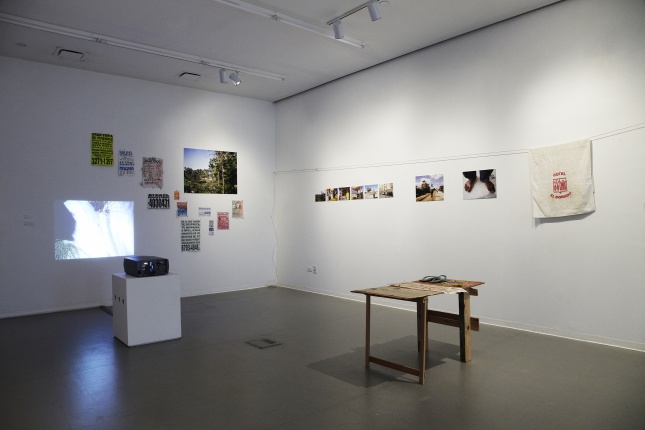“Walking Drifting Dragging” is a one-month-long presentation of works by four emerging artists/collectives: Eunji Cho (Seoul), Ellie Ga (New York), Paulo Nazareth (Belo Horizonte, Brazil), and Mriganka Madhukaillya and Sonal Jain of Desire Machine Collective (Guwahati, India).
“Museum as Hub: Walking Drifting Dragging,” 2013. Exhibition view: New Museum. Photo: Jesse Untracht-Oakner
Fifth Floor Visit Us
The artists share a common preoccupation with walking, roaming, and drifting—moving slowly, close to the ground—and documenting their travels within highly personal terms that blend cartography with memory. All four have embarked on epic journeys, such as crossing an entire continent on foot or floating through the darkness of the Arctic for months—each one motivated by a different impulse or political perspective. Collectively, the artists work against contemporary notions of immediacy and access in a globalized world where any data point appears to be a search away and other cultures can seem legible with a quick round-trip. Their works dramatize distance between countries and cultures, across borders and time zones, to demonstrate how layered and complex a local stretch of terrain can be.
 “Museum as Hub: Walking Drifting Dragging,” 2013. Exhibition view: New Museum. Photo: Jesse Untracht-Oakner
“Museum as Hub: Walking Drifting Dragging,” 2013. Exhibition view: New Museum. Photo: Jesse Untracht-Oakner
The themes of “Walking Drifting Dragging” took shape through dialogue between current Museum as Hub partners—art space pool, Seoul, de_sitio, Mexico City, Miami Art Museum, New Museum (founder), Townhouse Gallery, Cairo, and the Van Abbemuseum, Eindhoven—a network of international art spaces dedicated to international exchange through the support of emergent artistic and organizational practices. “Walking Drifting Dragging” is organized in conjunction with “Running On Borders,” an exhibition that will take place at art space pool in Seoul, South Korea, in 2013. It is organized by Lauren Cornell, Curator of the 2015 Triennial, Digital Projects and Museum as Hub.
The exhibition features the work Earth Thief (2009) by Eunji Cho, a performance, here shown as video documentation, in which the artist crossed hundreds of borders within the city of Berlin—some visible and active, others (like that of the Berlin Wall) now defunct. During her circular trip, she dragged a bag of dirt behind her, filling it with soil from different parks or plant beds and then letting it leak out as she walked. Connecting this work to her personal history, Cho, who was born in South Korea in the 1970s, explains, “The line is always in my mind,” referring to the border between North and South Korea. Her act of fertilizing areas of the city can be seen as an act of renewal: a free-form artistic re-zoning, where old borders are erased or muddled with new lines created in her wake. The artist Paulo Nazareth walked across national borders in a transcontinental route—that started in Belo Horizonte, Brazil, and led to New York City—allowing for many digressions and stops along the way. In Guatemala, for instance, he was temporarily adopted by a local family and everywhere he traveled he ate with strangers who became his temporary walking companions. The photographs, installation, and video that constitute his ambitious work “News from the Americas” (2011–12) capture the shifting perceptions of his identity that formed along his travels—in different places, navigating various national, cultural, and linguistic projections—working to break down a single conception of Latin America into hundreds of distinct, though interconnected, pieces.
Bhotbhoti Tales (2009) by Desire Machine Collective explores this same kind of shifting perception of a single entity, in this case the transnational Brahmaputra River, which has a different name in each region it borders—such as the Yarlung Tsangpo River in Tibet, Dihang and Brahmaputra in India, and the Jamuna in Bangladesh. In their video installation, Desire Machine Collective, who have taken up studio residence on a ferry in the Brahmaputra, speak with local boatmen about the river. What emerges is a multifaceted, contradictory view of the river’s geography and its lore; as the boatmen’s stories provide a depth and an anecdotal history that contemporary mapping technologies like Google Streetview or Earth cannot render. Finally, the show includes a collection of works by Ellie Ga that document her time aboard a ship that drifted through the glacial darkness of the Arctic for five months on a scientific expedition. The only artist on the boat, Ga counters the scientific measurements made by her co-travelers with more subjective ones: sketching the drift of the boat, measuring her possible walking distance at given stops; taking photographs of dawn and sunset. These works, alongside a video in which she narrates her experience, reflect the way she relinquished control over movement and time on the trip and surrendered to the processes of drift.
Artists’ journeys have been documented throughout art history: Those whose main practice has been “walking” include British artists Richard Long and Hamish Fulton, as well as others like Francis Alÿs, whose counterintuitive trip in “The Loop” (1997), from Mexico to California via a loop around the world (all to avoid the crossing of the US–Mexico border), was message-driven. “Walking Drifting Dragging” emerges from this history and provides a glimpse into contemporary practice of artist expeditions.









